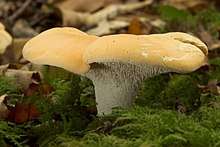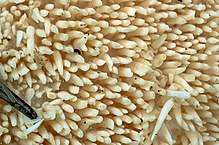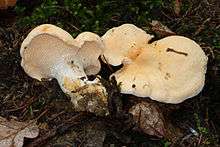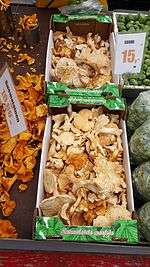Hydnum repandum
Hydnum repandum, commonly known as the sweet tooth, wood hedgehog or hedgehog mushroom, is a basidiomycete fungus of the family Hydnaceae. First described by Carl Linnaeus in 1753, it is the type species of the genus Hydnum. The fungus produces fruit bodies (mushrooms) that are characterized by their spore-bearing structures—in the form of spines rather than gills—which hang down from the underside of the cap. The cap is dry, colored yellow to light orange to brown, and often develops an irregular shape, especially when it has grown closely crowded with adjacent fruit bodies. The mushroom tissue is white with a pleasant odor and a spicy or bitter taste. All parts of the mushroom stain orange with age or when bruised.
| Hydnum repandum | |
|---|---|
 | |
| Scientific classification | |
| Kingdom: | Fungi |
| Division: | Basidiomycota |
| Class: | Agaricomycetes |
| Order: | Cantharellales |
| Family: | Hydnaceae |
| Genus: | Hydnum |
| Species: | H. repandum |
| Binomial name | |
| Hydnum repandum | |
| Synonyms[2] | |
| Hydnum repandum | |
|---|---|
float | |
| teeth on hymenium | |
| cap is depressed | |
| hymenium is decurrent | |
| stipe is bare | |
| spore print is white to cream | |
| ecology is mycorrhizal | |
| edibility: choice | |
A mycorrhizal fungus, Hydnum repandum is broadly distributed in Europe [7] where it fruits singly or in close groups in coniferous or deciduous woodland.[8][9] This is a choice edible species, although mature specimens can develop a bitter taste. It has no poisonous lookalikes. Mushrooms are collected and sold in local markets of Europe and Canada.[10]
Taxonomy
First officially described by Carl Linnaeus in his 1753 Species Plantarum, Hydnum repandum was sanctioned by Swedish mycologist Elias Fries in 1821.[11] The species has been shuffled among several genera: Hypothele by French naturalist Jean-Jacques Paulet in 1812; Dentinum by British botanist Samuel Frederick Gray in 1821; Tyrodon by Finnish mycologist Petter Karsten in 1881; Sarcodon by French naturalist Lucien Quélet in 1886.[2] After a 1977 nomenclatural proposal by American mycologist Ronald H. Petersen[12] was accepted, Hydnum repandum became the official type species of the genus Hydnum. Previously, supporting arguments for making H. repandum the type were made by Dutch taxonomist Marinus Anton Donk (1958)[13] and Petersen (1973),[14] while Czech mycologist Zdeněk Pouzar (1958)[15] and Canadian mycologist Kenneth Harrison (1971) thought that H. imbricatum should be the type.[16]
Several forms and varieties of H. repandum have been described. Forms albidum and rufescens, found in Russia, were published by T.L. Nikolajeva in 1961;[17] the latter taxon is synonymous with H. rufescens.[18] Form amarum, published from Slovenia by Zlata Stropnik, Bogdan Tratnik and Garbrijel Seljak in 1988,[19] is illegitimate as per article 36.1 of the International Code of Nomenclature for algae, fungi, and plants, as it was not given a sufficiently comprehensive description. French botanist Jean-Baptiste Barla described H. repandum var. rufescens in 1859.[20] English naturalist Carleton Rea described the white-fruit bodied version as a variety—H. repandum var. album—in 1922.[21]
Molecular studies have shown that the current species concept for H. repandum needed revision as there was a poor overlap between morphological and molecular species concepts. A 2009 Phylogenetic analysis of European specimens, based on internal transcribed spacer and 5.8S DNA sequences, indicated that H. repandum specimens form two distinct clades, whose only consistent morphological distinction is cap size. These genetic differences foreshadowed the presence of undescribed cryptic species, and that the taxon may currently be undergoing intensive speciation.[22] A comprehensive genetic study published in 2016 of members of the genus worldwide found that there are at least four species in the broad concept of H. repandum: two species from southern China, one from Europe and eastern North America, and H. repandum itself from Europe, western North America, and northern (and alpine southwestern) China and Japan. Although it is missing from Central America, genetic material has been recovered from Venezuela from the tree Pakaraimaea dipterocarpacea, suggesting it somehow migrated there and had changed hosts.[23]
The specific epithet repandum means "bent back", referring to the wavy cap margin. The varietal epithet album means "white as an egg".[24] Hydnum repandum has been given several vernacular names: "sweet tooth",[25] "yellow tooth fungus",[26] "wood urchin",[27] "spreading hedgehog",[28] "hedgehog mushroom", or "pig's trotter".[29] The variety album is known as "white wood".[24]
Description

The orange-, yellow- or tan-colored pileus (cap) is up to 17 cm (6 1⁄2 in) wide, although specimens measuring 25 cm (10 in) have been documented. It is generally somewhat irregular in shape (it may be convex or concave at maturity), with a wavy margin that is rolled inward when young.[29] Caps grow in a distorted shape when fruit bodies are closely clustered.[30] The cap surface is generally dry and smooth, although mature specimens may show cracking.[29] Viewed from above, the caps of mature specimens resemble somewhat those of chanterelles.[31] The flesh is thick, white, firm, brittle, and bruises yellow to orange-brown. The underside is densely covered with small, slender whitish spines measuring 2–7 mm (3⁄32–9⁄32 in) long.[29] These spines sometimes run down at least one side of the stipe.[27] The stipe, typically 3–10 cm (1–4 in) long and 1–3 cm (1⁄2–1 1⁄4 in) thick, is either white or the same color as the cap, and is sometimes off-center.[29] It is easy to overlook the mushrooms when they are situated amongst gilled mushrooms and boletes, because the cap and stipe are fairly nondescript and the mushrooms must be turned over to reveal their spines.[32] The pure white variety of this species, H. repandum var. album, is smaller than the main variety, with a cap measuring 2–7 cm (1–3 in) wide and a stipe that is 1–3 cm (1⁄2–1 1⁄4 in) long.[24]
The spore print is pale cream. Basidiospores are smooth, thin-walled and hyaline (translucent), roughly spherical to broadly egg-shaped, and measure 5.5–7.5 by 4.5–5.5 µm. They usually contain a single, large refractive oil droplet. The basidia (spore-bearing cells) are club-shaped, four-spored, and measure 30–45 by 6–10 µm. The cap cuticle is a trichodermium (where the outermost hyphae emerge roughly parallel, like hairs, perpendicular to the cap surface) of narrow, club-shaped cells that are 2.5–4 µm wide. Underneath this tissue is the subhymenial layer of interwoven hyphae measuring 10–20 µm in diameter. The spine tissue is made of narrow (2–5 µm diameter), thin-walled hyphae with clamp connections.[27]
Similar species
North American lookalikes include the white hedgehog (Hydnum albidum) and the giant hedgehog (Hydnum albomagnum). H. albidum has a white to pale yellowish grey fruit body that bruises yellow to orange. H. albomagnum is large and paler than H. repandum.[33] Hydnum umbilicatum is smaller, with caps measuring 3–5 cm (1–2 in) in diameter, and thinner stipes that are 0.5–1 cm (1⁄4–1⁄2 in) wide.[34] Its caps are umbilicate (with a navel-like cavity), sometimes with a hole in the center of the cap,[30] unlike the flattened or slightly depressed caps of H. repandum.[24] Microscopically, H. umbilicatum has spores that are larger and more elliptical than those of H. repandum, measuring 7.5–9 by 6–7.5 µm.[31] A European lookalike, Hydnum rufescens, is also smaller than H. repandum, and has a deeper apricot to orange color.[35] Hydnum ellipsosporum, described as a new species from Germany in 2004, differs from H. repandum by the shape and length of its spores, which are ellipsoid and measure 9–11 by 6–7.5 µm. Compared to H. repandum, it has smaller fruit bodies, with cap diameters ranging from 3 to 5 cm (1 to 2 in) wide.[36]
Ecology, habitat and distribution

H. repandum is a mycorrhizal fungus.[30] The fruit bodies grow singly, scattered, or in groups on the ground or in leaf litter in both coniferous and deciduous forests.[29][35] They can also grow in fairy rings.[37] Fruiting occurs from summer to autumn.[25] The species is widely distributed in Europe, [7] and is one of the most common of the tooth fungi.[29] In Europe, it has been listed as a vulnerable species in the Red Data Lists of the Netherlands, Belgium, and Germany; Sweden lists it as being of Least Concern.[38]
Edibility

H. repandum is considered to be a good edible, having a sweet, nutty taste and a crunchy texture. Some consider it the culinary equivalent of the chanterelle.[39] Author Michael Kuo gives it an edibility rating of "great" and notes that there are no poisonous lookalikes, and that H. repandum mushrooms are unlikely to be infested with maggots.
Delicately brushing the cap and stipe of specimens immediately after harvest will help prevent soil from getting lodged between the teeth. H. repandum mushrooms can be cooked by pickling,[40] simmering in milk or stock, and sautéeing, which creates a "tender, meaty texture and a mild flavor."[41] The mushroom tissue absorbs liquids well and assumes the flavors of added ingredients.[41] The firm texture of the cooked mushroom makes it suitable for freezing. Its natural flavor is reportedly similar to the peppery taste of watercress,[32] or oysters.[42] Older specimens may have a bitter taste, but boiling can remove the bitterness.[40] Specimens found under conifers can taste "unpleasantly strong".[43] The form amarum, locally common in Slovakia, is reportedly inedible because its fruit body has a bitter taste at all developmental stages.[19]
Hydnum repandum is frequently sold with chanterelles in Italy, and in France, it is one of the officially recognized edible species sold in markets.[37] In Europe, it is usually sold under its French name pied-de-mouton (sheep's foot).[33] It is also collected and sold in local markets of Mexico,[44] Spain[45] and British Columbia, Canada.[46] H. repandum mushrooms are also used as a food source by the red squirrel (Sciurus vulgaris).[47]
Nutrition
| Nutritional value per 100 g (3.5 oz) | |
|---|---|
| Energy | 1,431 kJ (342 kcal) |
4.3 g | |
19.7 g | |
| Vitamins | Quantity %DV† |
| Vitamin C | 1% 1.1 mg |
| Minerals | Quantity %DV† |
| Calcium | 60% 600 mg |
| Copper | 1945% 38.9 mg |
| Iron | 292% 38 mg |
| Magnesium | 65% 230 mg |
| Manganese | 1105% 23.2 mg |
| Potassium | 0% 2.89 mg |
| Sodium | 2% 31.9 mg |
| Zinc | 60% 5.72 mg |
| |
| †Percentages are roughly approximated using US recommendations for adults. Source: USDA Nutrient Database | |
Dried H. repandum is 56% carbohydrates, 4% fat, and 20% protein (table). In a 100 gram reference amount, several dietary minerals are high in content, especially copper and manganese. Major fatty acids include palmitate (16%), stearic acid (1%), oleic acid (26%), linoleic acid (48%), and linolenic acid (20%). Mycosterol is present.[49]
Phytochemicals
Both H. repandum and the variety album contain the diepoxide compound repandiol (2R,3R,8R,9R)-4,6-decadiyne-2,3:8,9-diepoxy-1,10-diol), which is under laboratory research to determine its possible effects.[50] The volatile phytochemicals responsible for the fruity aroma of the mushroom include eight-carbon derivatives, such as 1-octen-3-ol, (E)-2-octenol, and (E)-1,3-octadiene.[51] European studies conducted after the 1986 Chernobyl disaster showed that the fruit bodies have a high rate of accumulation of the radioactive isotope cesium.[52]
References
- Linnaeus C. (1753). Species Plantarum (in Latin). 2. Stockholm, Sweden: Impensis Laurentii Salvii. p. 1178.
- "Hydnum repandum L. 1753". MycoBank. International Mycological Association. Retrieved 28 September 2012.
- Schaffer JC. (1774). Fungorum qui in Bavaria et Palatinatu circa Ratisbonam nascuntur Icones (in Latin). 4. Regensburg, Germany: Apud J.J. Palmium. p. 99, plate 318.
- Gray SF. (1821). A Natural Arrangement of British Plants. London, UK: Baldwin, Cradock and Joy. p. 650.
- Karsten PA. (1881). "Enumeratio Hydnearum Fr. Fennicarum, systemate novo dispositarum". Revue Mycologique Toulouse (in Latin). 3 (9): 19–21.
- Quélet L. (1886). Enchiridion Fungorum in Europa media et praesertim in Gallia Vigentium (in Latin). Paris: Octave Dion. p. 189.
- Swenie, Rachel A.; Baroni, Timothy J.; Matheny, P. Brandon (2018-11-30). "Six new species and reports of Hydnum (Cantharellales) from eastern North America". MycoKeys. Pensoft Publishers. 42: 35–72. doi:10.3897/mycokeys.42.27369. ISSN 1314-4049.
- "Multilocus phylogenetic analyses reveal unexpected abundant diversity and significant disjunct distribution pattern of the Hedgehog Mushrooms ( Hydnum L.) - Scientific Reports". Nature. Retrieved 2019-11-18.
- "Hydnum repandum, Wood Hedgehog mushroom". Wildflowers, wild orchids, fungi, wildlife; nature books, reserves. Retrieved 2019-11-18.
- "Hedgehogs (Hydnum repandum)". Meronwood. Retrieved 2019-11-18.
- Fries EM. (1821). Systema Mycologicum (in Latin). 1. Lundin, Sweden: Ex Officina Berlingiana. p. 397.
- Petersen RH. (1977). "The typification of Hydnum Linn. per Fries: Time for stability". Taxon. 26 (1): 144–46. doi:10.2307/1220228. JSTOR 1220228.
- Donk MA. (1958). "Typification of the name Hydnum (Fungi)". Taxon. 7 (4): 96–97. doi:10.2307/1217430. JSTOR 1217430.
- Petersen RH. (1973). "The typification of Hydnum L. ex Fries". Taxon. 22 (1): 99–104. doi:10.2307/1218039. JSTOR 1218039.
- Pouzar Z. (1958). "Typification of the Genus Hydnum (Hymenomycetes)". Taxon. 7 (3): 79–80. doi:10.2307/1217522. JSTOR 1217522.
- Harrison KA. (1971). "Dentinum SF Gray or Hydnum L ex Fries". Mycologia. 63 (5): 1067–69. doi:10.2307/3757911. JSTOR 3757911.
- Nikolajeva TL. (1961). "Flora plantarum cryptogamarum URSS. Fungi. Familia Hydnaceae". Flora Plantarum Cryptogamarum URSS. 6 (2): 1–432 [306].
- "Hydnum repandum f. rufescens (Pers.) Nikol., Flora plantarum cryptogamarum URSS. Fungi. Familia Hydnaceae, 6(2): 305, 1961". MycoBank. International Mycological Association. Retrieved 7 September 2013.
- Stropnik Z, Tratnik B, Seljak G (1988). Naše Gobje Bogastvo (in Slovenian). Ljubljana: Mladinska Knjiga.
- Barla J-B. (1859). Les Champignons de la Province de Nice (in French). Nice, France: Canis Frères. p. 81.
- Rea C. (1922). British Basidiomycetae: A Handbook to the Larger British Fungi. Cambridge, UK: Cambridge University Press. p. 630.
- Grebenc T, Martín MP, Kraigher H (2009). "Ribosomal ITS diversity among the European species of the genus Hydnum (Hydnaceae)". Anales del Jardín Botánico de Madrid. 66 (S1): 121–32. CiteSeerX 10.1.1.626.4325. doi:10.3989/ajbm.2221.
- Feng B, Wang XH, Ratkowsky D, Gates G, Lee SS, Grebenc T, Yang ZL (2016). "Multilocus phylogenetic analyses reveal unexpected abundant diversity and significant disjunct distribution pattern of the Hedgehog Mushrooms (Hydnum L.)". Scientific Reports. 6. 25586. Bibcode:2016NatSR...625586F. doi:10.1038/srep25586. PMC 4858670. PMID 27151256.
- Roody WC (2003). Mushrooms of West Virginia and the Central Appalachians. Lexington, Kentucky: University Press of Kentucky. p. 398. ISBN 978-0-8131-9039-6.
- Phillips R. (2005). Mushrooms and Other Fungi of North America. Buffalo, New York: Firefly Books. p. 320. ISBN 978-1-55407-115-9.
- Schalkwijk-Barendsen HME. (1991). Mushrooms of Western Canada. Edmonton, Canada: Lone Pine Publishing. pp. 368–69. ISBN 978-0-919433-47-2.
- Pegler DN, Roberts PJ, Spooner BM (1997). British Chanterelles and Tooth Fungi. Kew, UK: Royal Botanic Gardens. pp. 40–41. ISBN 978-1-900347-15-0.
- McKnight VB, McKnight KH (1987). A Field Guide to Mushrooms: North America. Peterson Field Guides. Boston, Massachusetts: Houghton Mifflin. p. 90. ISBN 978-0-395-91090-0.
- Arora D. (1986). Mushrooms Demystified: A Comprehensive Guide to the Fleshy Fungi. Berkeley, California: Ten Speed Press. pp. 618–19. ISBN 978-0-89815-169-5.
- Laessoe T, Lincoff G (2002). Mushrooms. Smithsonian Handbooks (2nd ed.). London: Dorling Kindersley Adult. p. 238. ISBN 978-0-7894-8986-9.
- Kuo M. (August 2003). "Hydnum repandum". MushroomExpert.Com. Retrieved 8 September 2013.
- Abel D, Horn B, Kay R (1993). A Guide to Kansas Mushrooms. Lawrence, Kansas: University Press of Kansas. pp. 203–04. ISBN 978-0-7006-0571-2.
- Roberts P, Evans S (2011). The Book of Fungi. Chicago, Illinois: University of Chicago Press. p. 471. ISBN 978-0-226-72117-0.
- Davis RM, Sommer R, Menge JA (2012). Field Guide to Mushrooms of Western North America. Berkeley, California: University of California Press. p. 283. ISBN 978-0-520-95360-4.
- Sterry P, Hughes B (2009). Complete Guide to British Mushrooms and Toadstools. London, UK: Collins. p. 300. ISBN 978-0-00-723224-6.
- Ostrow H, Beenkin L (2004). "Hydnum ellipsosporum spec. nov. (Basidiomycetes, Cantharellales) – ein Doppelganger von Hydnum rufescens Fr" [Hydnum ellipsosporum spec. nov (Basidiomycetes, Cantharellales) – a double of Hydnum rufescens Fr.] (PDF). Zeitschrift für Mykologie (in German). 70 (2): 137–56. Archived from the original (PDF) on 2016-07-01. Retrieved 2015-10-07.
- Dickinson C, Lucas J (1982). VNR Color Dictionary of Mushrooms. New York, New York: Van Nostrand Reinhold. p. 46. ISBN 978-0-442-21998-7.
- Arnolds E. (2010). "The fate of hydnoid fungi in The Netherlands and Northwestern Europe". Fungal Ecology. 3 (2): 81–88. doi:10.1016/j.funeco.2009.05.005.
- Ammirati JF, McKenny M, Stuntz DE (1987). The New Savory Wild Mushroom. Seattle, Washington: University of Washington Press. p. 173. ISBN 978-0-295-96480-5.
- Mabey R. (2007). Food for Free. London, UK: Collins. pp. 196–97. ISBN 978-0-00-724768-4.
- Kuo M. (2007). 100 Edible Mushrooms. Ann Arbor, Michigan: The University of Michigan Press. pp. 104–06. ISBN 978-0-472-03126-9.
- Sept JD. (2006). Common Mushrooms of the Northwest: Alaska, Western Canada & the Northwestern United States. Sechelt, British Columbia: Calypso Publishing. p. 67. ISBN 978-0-9739819-0-2.
- Courtecuisse R. (1999). Mushrooms of Britain and Europe. Collins Wildlife Trust guides. London: Harpercollins. p. 325. ISBN 978-0-00-220012-7.
- Dugan (2011), p. 75.
- Dugan (2011), p. 44.
- Dugan (2011), p. 91.
- Grönwall O, Pehrson Å (1984). "Nutrient content in fungi as a primary food of the red squirrel Sciurus vulgaris L". Oecologia. 64 (2): 230–31. Bibcode:1984Oecol..64..230G. doi:10.1007/BF00376875. PMID 28312343.
- Nutritional values are based on chemical analysis of specimens collected from the East Black Sea region in Turkey. Source: Ayaz FA, Torun H, Özel A, Col M, Duran C, Sesli E, Colak A (2011). "Nutritional value of edible wild mushrooms collected from Black Sea region (Turkey)" (PDF). Turkish Journal of Biochemistry. 36 (3): 213–21.
- Kalač P. (2009). "Chemical composition and nutritional value of European species of wild growing mushrooms: A review". Food Chemistry. 113 (1): 9–16. doi:10.1016/j.foodchem.2008.07.077.
- Takahashi A, Endo T, Nozoe S (1992). "Repandiol, a new cytotoxic diepoxide from the mushrooms Hydnum repandum and H. repandum var. album". Chemical & Pharmaceutical Bulletin. 40 (12): 3181–84. doi:10.1248/cpb.40.3181. PMID 1294319.
- Fons F, Rapior S, Eyssartier G, Bessiere JM (2003). "Les substances volatiles dans les genres Cantharellus, Craterellus et Hydnum" [Volatile compounds in the Cantharellus, Craterellus and Hydnum genera]. Cryptogamie. Mycologie (in French). 24 (4): 367–76.
- Stachowiak B, Reguła J (2012). "Health-promoting potential of edible macromycetes under special consideration of polysaccharides: A review". European Food Research and Technology. 234 (3): 369–80. doi:10.1007/s00217-011-1656-9.
Cited literature
- Dugan FM (2011). Conspectus of World Ethnomycology. St. Paul, Minnesota: American Phytopathological Society. ISBN 978-0-89054-395-5.
External links

